The only ring on a 6.5 that is gapless is the 2nd, but you need to replace them all while your right there.
Navigation
Install the app
How to install the app on iOS
Follow along with the video below to see how to install our site as a web app on your home screen.
Note: This feature may not be available in some browsers.
More options
-
Welcome to The Truck Stop! We see you haven't REGISTERED yet.
Your truck knowledge is missing!
- Registration is FREE , all we need is your birthday and email. (We don't share ANY data with ANYONE)
- We have tons of knowledge here for your diesel truck!
- Post your own topics and reply to existing threads to help others out!
- NO ADS! The site is fully functional and ad free!
Problems registering? Click here to contact us!
Already registered, but need a PASSWORD RESET? CLICK HERE TO RESET YOUR PASSWORD!
You are using an out of date browser. It may not display this or other websites correctly.
You should upgrade or use an alternative browser.
You should upgrade or use an alternative browser.
Changing 1994 6.5 For 1990 6.2
- Thread starter handcannon
- Start date
ak diesel driver
6.5 driver
handcannon
Well-Known Member
Sorry Leroy, I wasn't very clear in specifying what I was talking about. I was thinking in terms of the set of rings you have that are without the second ring.
Don
Don
handcannon
Well-Known Member
Thanks ak. Good to know the price of making them gapless.
Don
Don
Right. I have that set you can have if you need a standard bore 6.5 set, you just need to come up with the 2nd ring.Sorry Leroy, I wasn't very clear in specifying what I was talking about. I was thinking in terms of the set of rings you have that are without the second ring.
Don
It's too hot ~110, with some humidity, for me to play with the project truck. So I work at night when it's reasonable.
Throw a chain at it already. Make sure to use new keys...
I'll chip in what I can to upgrade you to gapless rings. The file fit is a downside if you are paying for that to be done so get us a estimate from the machine shop for doing so.
Did they replace all the gears in the transmission or just the OD set? The OD set is known for wearing out.
Throw a chain at it already. Make sure to use new keys...
I'll chip in what I can to upgrade you to gapless rings. The file fit is a downside if you are paying for that to be done so get us a estimate from the machine shop for doing so.
Did they replace all the gears in the transmission or just the OD set? The OD set is known for wearing out.
hookedup50
Well-Known Member
Don, PM me an address and I'll get the timing set out by weeks end. Like WW said, change it out while your'e there
handcannon
Well-Known Member
It's too hot ~110, with some humidity, for me to play with the project truck. So I work at night when it's reasonable.
Throw a chain at it already. Make sure to use new keys...
I'll chip in what I can to upgrade you to gapless rings. The file fit is a downside if you are paying for that to be done so get us a estimate from the machine shop for doing so.
Did they replace all the gears in the transmission or just the OD set? The OD set is known for wearing out.
I just can't imagine that kind of temps. Here in western Oregon we melt when it gets into the upper 90's. Yesterday was in the low to mid 90's. Today is supposed to hit about 100. Tomorrow about 105. Friday about 103. then it's supposed to start a gradual cooling trend down to the mid 80's.
hookedup50 is going to send a timing chain my way. I really do appreciate all the offers for help. I wasn't expecting that, only asking a question about the reluctor. Thanks!! to all of you for your offers for help.
I don't know exactly what Chris has replaced in the transmission. He did tell me what he had to replace to get the correct settings, but I don't know auto trans very well and I just don't remember what he said (maybe planetaries?). I told him to rebuild with the idea that I would be towing with it, not real heavy, just a travel trailer. He was going to go with better,heavy duty 3-4 clutches and I think mod the "brain" (can't think of the correct terminlogy at the moment) for better holding power. The trans had been running good. I had just started noticing a small amount of slipping during the 3-4 shift. The trans fliud was just beginning to darken up a bit, but I could still see some red to the fluid. I don't have any history for the motor/trans from before about 160K, and have almost 254K on it now. I've had the pickup for just over 20K miles.
I spent the morning moving the motor over so I could use the concrete apron for the motor stand. I had close to 15 feet to move the motor. Lift the motor a few inches, swing it forward, set it down on blocks, move the lift forward a few inches, then start all over again. Finally got it to the apron and the stand. Jefferson is only 3 miles away, so I went in there to get the bolts needed to mount the motor to the stand, but they didn't have anything long enough. So, I had to go into Albany.
Finally got the motor on the stand, and removed the pan bolts. Somebody has had the pan off before. As previously mentioned they used an extreme amount of silicone gasket maker. The pan was glued down real tight. I finally got it off, and the evidence of excessive silicone was all the way around. Most of the pan bolts had a quarter inch of dried silicone on the ends of them. There was even a chunk of dried/hardened silicone (about the size of what I found on the pan bolt ends) stuck to the oil pump screen.
I checked the 3 main webs, and to my untrained eye I could only see one spot that might be a crack, about 3/16ths inch long. By this time it was getting so warm, and too bright, to be able to see the webs very good. So this evening when the shade finally gets back there I will try to get some pics, with my daughters help, so that others with more experience can also look at the webs.
If the webs are indeed in good shape I will then remove the heads to see what I find on that side of the block. My next concern is the condition of the rings, pistons, and cylinder walls. I pulled the glows to see if there would be any evidence on them to tell me more about what the "lifter knock" might actually be. I could only see extra carbon on the third from the front on the passenger side. Everything else about them seemed to all be the same. They are Bosch Duraterms with no more than 20K on them. Later I will test them to make sure they are all working properly.
Don
handcannon
Well-Known Member
Well, after all the days lost to other things that had to be done, I finally got the pistons out of the 6.5 this evening. Up to this point I had been real hopeful. Just by visual inspection, to this untrained eye, when I checked the main webs I could only see one very small crack, no more than 1/4 inch long. But, five of the eight cylinders had score marks, some so deep that they were very easy to feel. Some of the pistons, between the piston crown and the first ring, were very bad scored. Very disappointing, to say the least.
I am wondering if this motor has had major work done on it before. The rods on the first three pistons on the drivers side bank had an "S" stamped on the right side. The last piston on the drivers side bank had an "H" on the right side. The rods on the passenger bank had an "L" stamped on the left side. ??? Also, I have questions about the pushrods. As I would expect, each rod had a hole in each end. But, each rod also had a small hole on the side, about an inch from one end. Some of the rods had the small holes positioned down next to the lifters, and some had these holes up next to the rockers. ???
The pre-cups had a large dot stamped into them. All were cracked, I'm not surprised. But, several were cracked almost to where the fire ring crossed the cup. Still not surprising going by what I've read about pre-cups on this forum. Going by what I could see, there are no cracks between the valves. After what I found with the pistons/cylinders I stopped and have not removed the cam or crank yet.
I still have not found anything that I could easily say was causing the "collapsed lifter" sound. Although, because of my lack of experience I could easily be missing something.
At this point I'm going to have to take the 6.5 off the engine stand and put the 6.2 on it and see what the main webs look like. If the webs look good I will pull the heads and compare them to the 6.5 heads. If I use the 6.5 heads the pre-cups will need to be replaced anyway, so it looks I might have some head work to be done.
I'm feeling a bit apprehensive.
Don
I am wondering if this motor has had major work done on it before. The rods on the first three pistons on the drivers side bank had an "S" stamped on the right side. The last piston on the drivers side bank had an "H" on the right side. The rods on the passenger bank had an "L" stamped on the left side. ??? Also, I have questions about the pushrods. As I would expect, each rod had a hole in each end. But, each rod also had a small hole on the side, about an inch from one end. Some of the rods had the small holes positioned down next to the lifters, and some had these holes up next to the rockers. ???
The pre-cups had a large dot stamped into them. All were cracked, I'm not surprised. But, several were cracked almost to where the fire ring crossed the cup. Still not surprising going by what I've read about pre-cups on this forum. Going by what I could see, there are no cracks between the valves. After what I found with the pistons/cylinders I stopped and have not removed the cam or crank yet.
I still have not found anything that I could easily say was causing the "collapsed lifter" sound. Although, because of my lack of experience I could easily be missing something.
At this point I'm going to have to take the 6.5 off the engine stand and put the 6.2 on it and see what the main webs look like. If the webs look good I will pull the heads and compare them to the 6.5 heads. If I use the 6.5 heads the pre-cups will need to be replaced anyway, so it looks I might have some head work to be done.
I'm feeling a bit apprehensive.
Don
Will L.
Well-Known Member
Can you post pics of the rods showing the hole in the side? If I understand right it would dump out oil instead of pushing it up to the rocker arms. Dry rocker arm/push rod junction would cause a flattened wear point and a ticking. If that's the case,
Inspect the rocker arm seats really well.
Inspect the rocker arm seats really well.
handcannon
Well-Known Member
I will get some pics tomorrow morning. Hopefully I can figure out how to post them. I do have a lot of pics of other parts also, main webs, etc, but none yet of the pistons and cylinders. I will need to clean them up first though as they are very oily and black at the moment.
I was looking at where the rockers pivot on the shaft and wondering how much looseness/slop was supposed to be there. I didn't take time to try to measure, but it sure looked to me like about 1/32 inch of clearance there. However, the pushrod and spring load of the valve spring would keep the bottom of the rocker arm tight against the shaft. Without taking the rocker assembly apart it's hard to know for sure, but the inside of the rocker, where it pivots against the shaft, appears to be smooth similar to the inside of a bushing.
Don
I was looking at where the rockers pivot on the shaft and wondering how much looseness/slop was supposed to be there. I didn't take time to try to measure, but it sure looked to me like about 1/32 inch of clearance there. However, the pushrod and spring load of the valve spring would keep the bottom of the rocker arm tight against the shaft. Without taking the rocker assembly apart it's hard to know for sure, but the inside of the rocker, where it pivots against the shaft, appears to be smooth similar to the inside of a bushing.
Don
handcannon
Well-Known Member
Here's a pic of a pushrod. This morning I took one, wiped it down, and tried to push a oxy-acetylene tip cleaner through the hole in the side. What I found was that it is only an indent in the surface. What I find puzzling is the purpose for the indent. If it is used to pin the tip of the rod into place, why is it only on one end? If the rod tube is crimped over the machined tip of the rod end to hold it in place, why is the indent needed?
My little camera will not take good close-ups. So I enlarged the pic on my computer, but don't know how to put the enlarged pic in this post. You can just see the indented area close to the ball on the end of the rod. (posting this pic wasn't hard at all, so I'm going to post more pics of what I found on most of the pistons, and most of the cylinders in the next post)
Don
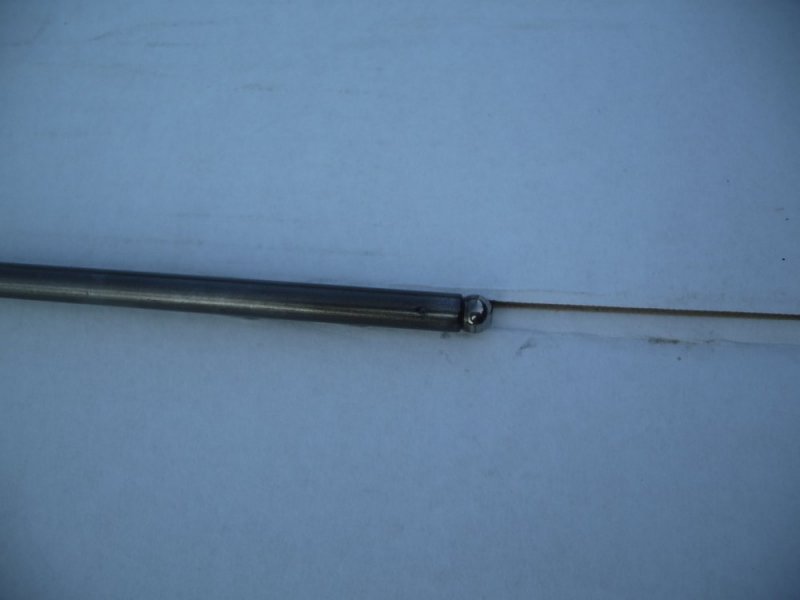
My little camera will not take good close-ups. So I enlarged the pic on my computer, but don't know how to put the enlarged pic in this post. You can just see the indented area close to the ball on the end of the rod. (posting this pic wasn't hard at all, so I'm going to post more pics of what I found on most of the pistons, and most of the cylinders in the next post)
Don

handcannon
Well-Known Member
Here's pics of the passenger bank part of the block, with the pistons still in place. The first pic is of the rear most cylinder on the left. The second pic has the front cylinder on the right. What I'm questioning is the differing pattern left by the flame front on the top of the piston. Any ideas about the reason?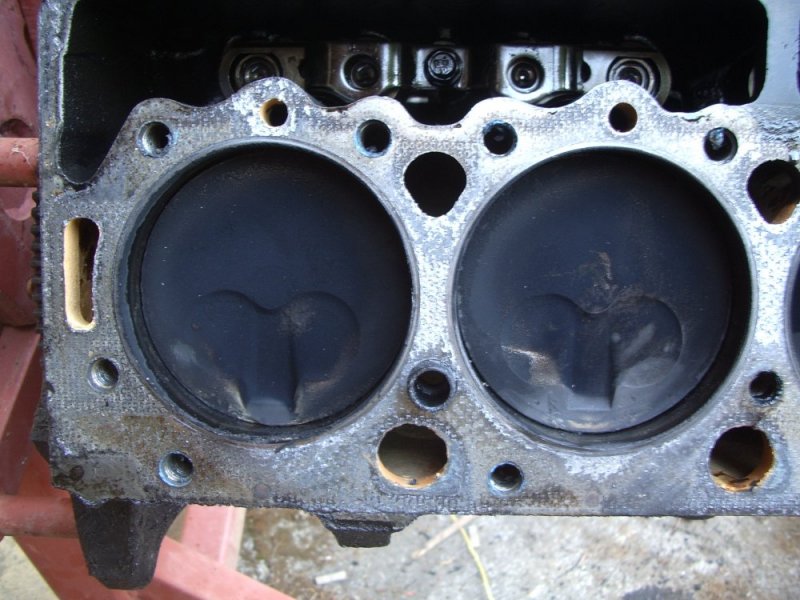
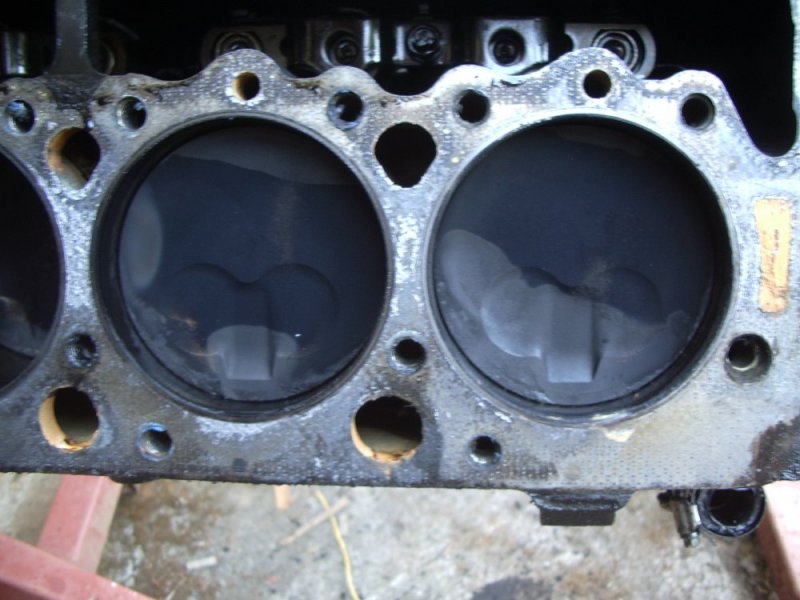
Here's pics of the passenger head. They are in the same order as the first two pics, rearmost cylinder on left, and front cylinder on right. Note the difference in the flame front pattern here also.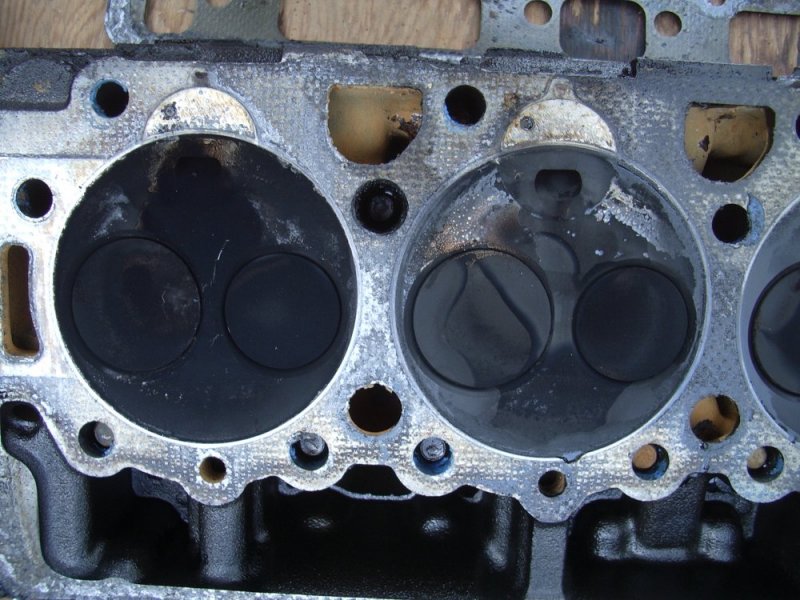
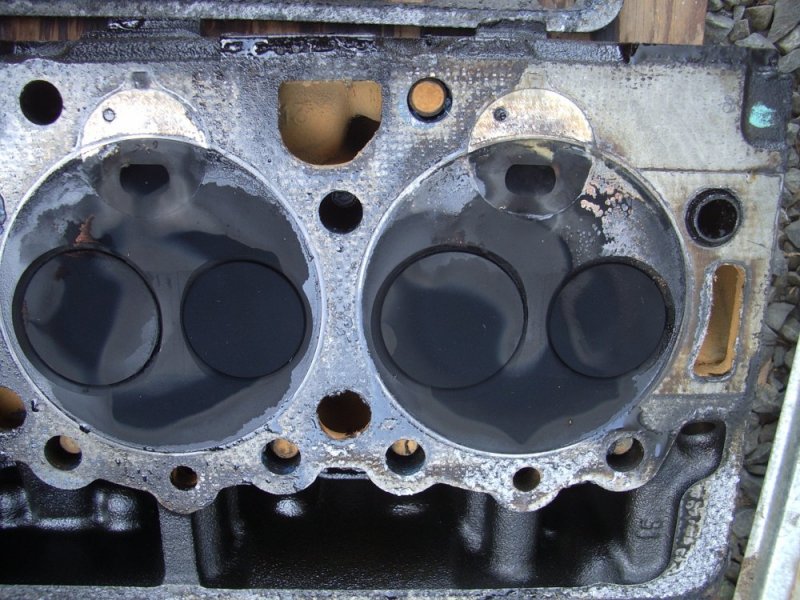
Here's some pics of one cylinder and piston. Not all are this bad, but many are not far from that. Notice the way the rings also show the scoring. I apologize for the fuzzy pic. I will blame that on the camera, not me, never (he he). The scoring is real deep. Any questions as to why the motor had massive blow-by? What surprises me after seeing all this, the motor was still running decently. Obviously, in order to use this block will require boring and new pistons, which I can't afford at this time. Hopefully the 6.2 will look much better when I pull the pan, and then the heads.
Don
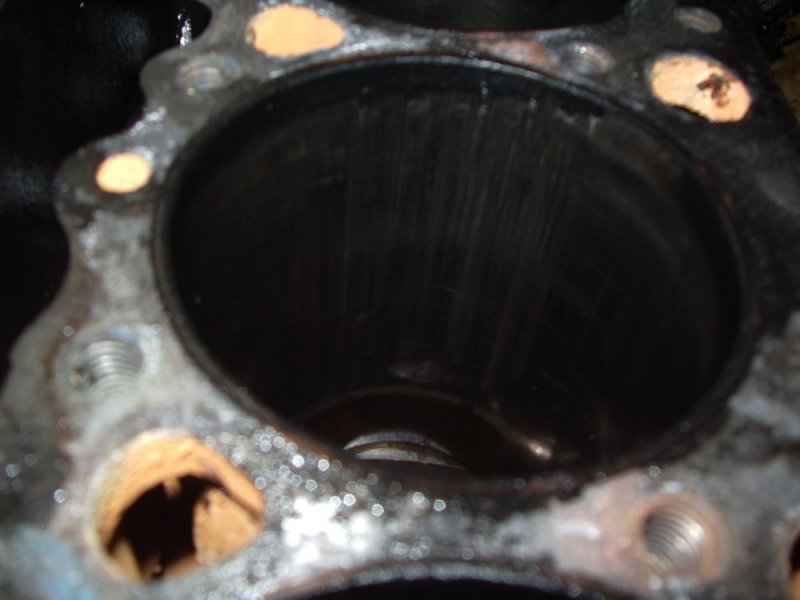
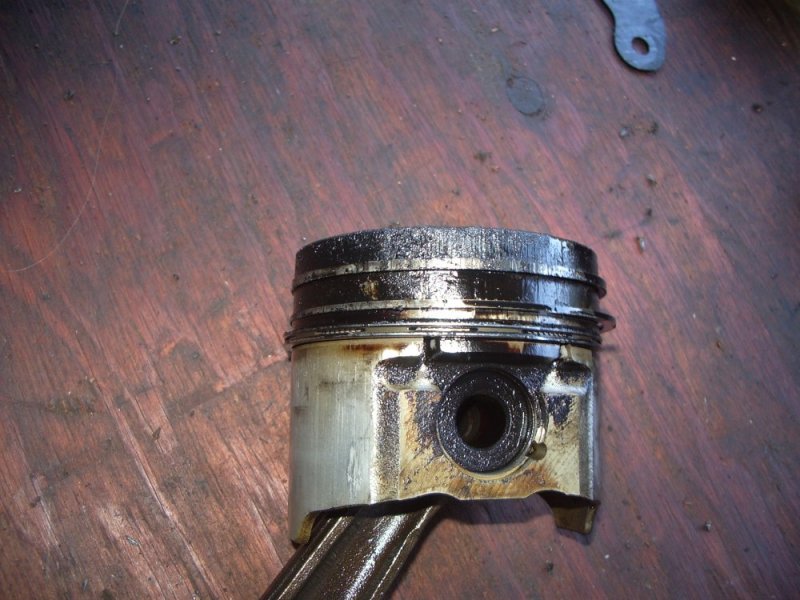


Here's pics of the passenger head. They are in the same order as the first two pics, rearmost cylinder on left, and front cylinder on right. Note the difference in the flame front pattern here also.


Here's some pics of one cylinder and piston. Not all are this bad, but many are not far from that. Notice the way the rings also show the scoring. I apologize for the fuzzy pic. I will blame that on the camera, not me, never (he he). The scoring is real deep. Any questions as to why the motor had massive blow-by? What surprises me after seeing all this, the motor was still running decently. Obviously, in order to use this block will require boring and new pistons, which I can't afford at this time. Hopefully the 6.2 will look much better when I pull the pan, and then the heads.
Don


Indent help ID the direction for reinstall.
handcannon
Well-Known Member
That's good to know Leroy. Thanks!!
However, when I removed them they were in place either direction, not all facing one way. More reason to think this motor has been apart before, and not carefully reassembled.
Don
However, when I removed them they were in place either direction, not all facing one way. More reason to think this motor has been apart before, and not carefully reassembled.
Don
Also, I have questions about the pushrods. As I would expect, each rod had a hole in each end. But, each rod also had a small hole on the side, about an inch from one end. Some of the rods had the small holes positioned down next to the lifters, and some had these holes up next to the rockers. ???
You have identified the problem. The pushrods are hardened on one end only. Installing them upside down, as some of yours were, causes extreme wear on the rockers and the pushrods. Thus wear = noise. Throw away the rockers and push rods they are DONE!
I would look at the air intake for dirt getting in. Possible overheating and oil failure in the past. You are seeing oil interact in the combustion chamber as well as uneven compression.
Last edited:
Will L.
Well-Known Member
I agree with your assessment of been rebuilt before incorrectly. Also why you are getting the damage you did from piston scoring the walls. I would even question the crank and cam at this point. Cam is most likely ok, but if you don't know how to check the crank, have it measured out.
Part of the reason diesels run longer than gas is because there is so much room for loss inherently. Yes you lost a lot of compression, if you had started with the 18:1 you would not get as many miles. There is so much torque even at idle that the engine can "push through" problems like Pistons dragging walls and lost power from improper injector pattern.
Which those are the 2 reasons for the soot Patterson you're seeing in the different chambers. Lost compression in one cylinder can't moated to another and worn injectors with different fuel spray coming out the precups. I bet if you studied the worn Pistons, cylinder walls closely you would see relation to the soot pattern.
Part of the reason diesels run longer than gas is because there is so much room for loss inherently. Yes you lost a lot of compression, if you had started with the 18:1 you would not get as many miles. There is so much torque even at idle that the engine can "push through" problems like Pistons dragging walls and lost power from improper injector pattern.
Which those are the 2 reasons for the soot Patterson you're seeing in the different chambers. Lost compression in one cylinder can't moated to another and worn injectors with different fuel spray coming out the precups. I bet if you studied the worn Pistons, cylinder walls closely you would see relation to the soot pattern.
handcannon
Well-Known Member
I re-read BowtieButler's thread where he re-built on a budget. Great thread, and very inspiring, however my budget is even tighter than his.
I got the 6.2 mostly torn down. The main webs look good except for one possible small crack about 5/16ths inch long in the center web. How do you tell if it is really a crack? I wish I knew what kind of oil was used in this motor as it really clings to all surfaces, much more than for when I tore down the 6.5. The oil clinging to surfaces makes it much harder to check the main webs. I had the block upside down, wiped the web surfaces that were exposed when the crank was turned, and then let it set for quite a while. When I then looked at them, oil had run down onto the webs again, which I had no problem with on the 6.5.
How do you tell if it is standard size bore by looking at pistons (don't have them out yet)? Seven have the letter "C" stamped into the top, while one has "D" stamped into the top. The bores look good to me, no scratches, etc, except for lots of carbon buildup. The cross hatch marks are visible, though not real strongly visible. There is a small amount of rust in a few cylinders. The block shows to have been pressure washed, and I think a little bit of water got inside. I don't think it is bad enough but that honing and re-ringing would take care of it (I don't have any way to properly measure the cylinders). Probably would have been OK even if the motor had been run without tearing down, however rust may have been too gritty for long ring life.
I haven't looked at rod or main bearings yet. I don't intend to take them off until I get some advice from you guys. My thoughts are to remove the rod caps and use their condition to help me decide about the mains. Maybe just do the mains anyway and polish the crank, as any problems in the renewed block would require pulling the motor. What have others done successfully?
In order to save funds I am considering using the heads from the 6.5 as is since they appear to be in real good shape, and were not giving me any problems. Having the heads/valves re-conditioned locally would cost me at least $250, which would have to go on plastic as I don't have the funds (I've been trying to pay down our high card balances, but losing ground now). Buying the rings and bearings is going to be tough enough that I need to consider all cost saving methods that are not going to cost me more in the long run. Heads can be removed later, if future work is needed. Then hone and re-ring to clean up the small amount of rust.
I don't know yet about the pushrods as the ones I took out of the 6.2 weren't all installed the same way (looking at the dots on the side of the rod). Most were installed the same way, but a few were installed upside down, unlike in the 6.5 which were really mixed up. My big question is-- Both ends look identical, yet only one end is supposedly hardened, and have to be installed one way only. Which end is which? Or, are both ends actually the same in looks and hardness? To my eye I don't see any visual difference between the two.
I've got to get outside now and start cleaning parts in preparation for putting it back together.
Don
I got the 6.2 mostly torn down. The main webs look good except for one possible small crack about 5/16ths inch long in the center web. How do you tell if it is really a crack? I wish I knew what kind of oil was used in this motor as it really clings to all surfaces, much more than for when I tore down the 6.5. The oil clinging to surfaces makes it much harder to check the main webs. I had the block upside down, wiped the web surfaces that were exposed when the crank was turned, and then let it set for quite a while. When I then looked at them, oil had run down onto the webs again, which I had no problem with on the 6.5.
How do you tell if it is standard size bore by looking at pistons (don't have them out yet)? Seven have the letter "C" stamped into the top, while one has "D" stamped into the top. The bores look good to me, no scratches, etc, except for lots of carbon buildup. The cross hatch marks are visible, though not real strongly visible. There is a small amount of rust in a few cylinders. The block shows to have been pressure washed, and I think a little bit of water got inside. I don't think it is bad enough but that honing and re-ringing would take care of it (I don't have any way to properly measure the cylinders). Probably would have been OK even if the motor had been run without tearing down, however rust may have been too gritty for long ring life.
I haven't looked at rod or main bearings yet. I don't intend to take them off until I get some advice from you guys. My thoughts are to remove the rod caps and use their condition to help me decide about the mains. Maybe just do the mains anyway and polish the crank, as any problems in the renewed block would require pulling the motor. What have others done successfully?
In order to save funds I am considering using the heads from the 6.5 as is since they appear to be in real good shape, and were not giving me any problems. Having the heads/valves re-conditioned locally would cost me at least $250, which would have to go on plastic as I don't have the funds (I've been trying to pay down our high card balances, but losing ground now). Buying the rings and bearings is going to be tough enough that I need to consider all cost saving methods that are not going to cost me more in the long run. Heads can be removed later, if future work is needed. Then hone and re-ring to clean up the small amount of rust.
I don't know yet about the pushrods as the ones I took out of the 6.2 weren't all installed the same way (looking at the dots on the side of the rod). Most were installed the same way, but a few were installed upside down, unlike in the 6.5 which were really mixed up. My big question is-- Both ends look identical, yet only one end is supposedly hardened, and have to be installed one way only. Which end is which? Or, are both ends actually the same in looks and hardness? To my eye I don't see any visual difference between the two.
I've got to get outside now and start cleaning parts in preparation for putting it back together.
Don
handcannon
Well-Known Member
By the way, my current thoughts, considering what I have found. Get this 6.2 back together and running as good as possible without spending a lot of money on it, so that I have a reliable pickup to drive. Then, in the future, as funds will allow, do a thorough rebuild on the 6.5.
Don
Don
ak diesel driver
6.5 driver
need to check the guides in the 6.5 heads before you claim them as good. Grab ahold of the spring end and yank it back and forth as in towards the cam and then away from it. With the springs on it you shouldn't really have any play. Better would be to remove the spring and then wiggle it the same way. Definitely make sure the short block is in as good of condition as you can afford. Sounds like the 6.5 isn't a very good candidate for rebuilding
